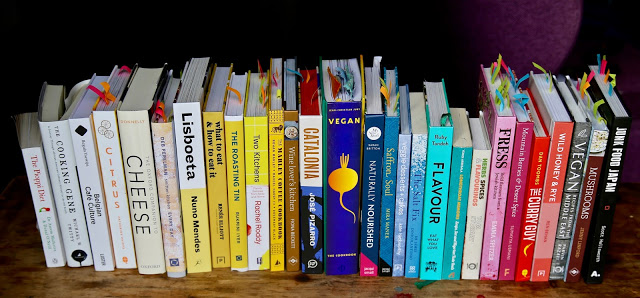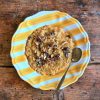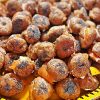Here is my annual food book round-up, published in mid-November to help you decide which books to buy for Christmas. I’ve divided my book selections into sections:
- Food from around the world
- Food anthropology or memoir
- Ingredient-led cookbooks
- General cookbooks
- Vegan
- Books by Doctors
Food from around the world
Junk Food Japan, Addictive Food from Kurobuta by Scott Hallsworth (Absolute Press)
I ate at Hallsworth’s Marble Arch restaurant Kurobuta. It was delicious but expensive. (Name drop; I was with Marina O’Loughlin, the Sunday Times new restaurant columnist.) This book is your opportunity to make this food at a fraction of the price. Australian Hallsworth spent 6 years at Nobu, where he fell in love with Japanese fusion cooking. Unlike most chef books, this one seems to be actually written by him. The punk styling can seem a little forced (the man was born in the mid-70s) and there is a touch of macho Bourdainism with the swearing, but the recipes are doable, creative, simple and alluring. He knows of what he speaks, mentioning new season sushi rice, which needs less water than older rice. Energetic, nicely styled photography by David Loftus.
I want to make: broad bean tempura with wasabi salt; iced sweet and sour nasu; Jerusalem artichoke chopsticks with truffle ponzu.
Mountain Berries and Desert Spice, sweet inspiration from the Hunza Valley to the Arabian Sea by Sumayya Usmani (Frances Lincoln)
Sumayya used to be a neighbour, living in Queen’s Park before bolting to Scotland. Her second book (the first being Summers under the Tamarind Tree) focusses on Pakistani desserts. The book explores the landscape and ingredients of Pakistan, sandwiched between India, China Afghanistan and Iran. Out of all the books I reviewed, this one had the most post-it notes stuck between pages, for recipes I want to make. Beautiful styling, propping and photography by Joanna Yee.
I want to make: Parsi wedding custard with rose petals and apricots, turmeric Jalebis, saffron caramels and poppy seeded cones of kulfi.
Two Kitchens, family recipes from Sicily and Rome by Rachel Roddy (Headline)
I’m going to say that this book is even better than the award-winning Five Quarters. Apart from the jarring cover, I love every page. Rachel’s recipes are very relatable; they look messy and homely. It’s not the alien aspirational food of high-end chefs. The best food often doesn’t look great on Instagram; it can be brown or beige, shiny and cooked. Unstyled. You feel like you can pick up the food and eat it. Roddy’s food books are intimate and domestic with casual chiaroscuro photographs of family moments.
I want to make: mandarin orange jelly, taralli al limone, nociata, broad bean, fennel and mint salad.
Fress, bold flavours from a Jewish Kitchen by Emma Spitzer (Octopus)
Emma Spitzer is a local (North West London) food writer who competed on MasterChef. This is very much a family cookbook with a genealogical tree in the introduction and her children featuring in the photographs. Emma seems like a superwoman: four kids, a travel business AND dedicated cook. She’s honest about her homely food – portions err on the generous and plating is something she had to learn on MasterChef. Her Jewish food hails from both traditions, Eastern European Ashkenazi and Iberian Sephardi, including both smoked salmon schmear (love that word) and schupfenudeln (a potato noodle). Nice photography and styling by Clare Winfield’s team.
I want to make: Amba spiced courgettes with barberries and labneh, Chrain (a horseradish and beetroot sauce), fennel and potato latkes, chocolate babka.
Wild honey and rye by Ren Behan (Pavilion)
Since Poland became part of the EU and the Polish diaspora moved to the UK, sparking a wealth of Polish corner shops, I’ve been interested in what you can make with the intriguing ingredients. Ren is a food blogger of Polish heritage and I’ve been waiting for a smart publisher to commission her to write this book. It doesn’t disappoint. She talks of her childhood going to Polish church and visiting the Polish Ex-Combatants Club but the recipes in this book are modern, lighter than traditional Eastern European food. Appealing photography and styling by Yuki Sugiura and her team.
I want to make: apple mashed potatoes; homemade dill pickles; pierogi.
The Curry Guy by Dan Toombs (Quadrille)
I always thought Dan’s book would sell, which is why I recommended him to my agent. Just like in other areas of life, men buy books written by men. Typical curry house recipes are exactly the sort of thing men want to cook. Dan has investigated curry house tricks by going into Indian restaurants all over Britain. There are all the old curry house classics and a few tips for prepping large quantities of curry sauce and pre-cooked potatoes. This is his first book, and he’s been signed up for several others.
I’ve made tandoori beetroot paneer, and it was delicious.
Saffron Soul by Mira Manek (Jacqui Small LLP)
I’d like to make: charred masala corn cobs, carrot halwa, thandai, saffron limeade.
Lisboeta by Nuno Mendes (Bloomsbury)
This is almost more of a photo travelogue than a cookbook. Last year I predicted that Portugal would be the next big place – now even Madonna has moved there (to support her son David Banda’s budding football career). I ate at Mendes’ ‘The Loft’ supper club and out of all the experimental food he served, the simply cooked Portuguese fish dish was the most sublime.
This hefty book has almost too much to say: tucked between glossy pages are smaller matte pamphlets on Tascos (neighbourhood Lisboan restaurants), cafe culture, fish, beach life, Santo Antonio.
Great photography by Andrew Montgomery.
I’d like to make: runner bean fritters with clam broth; tomato soup, all the pastries, potatoes with caramelised onions and melting cheese.
Catalonia by José Pizarro (Hardie Grant)
Beautifully designed book on a very news-worthy topic, Catalonia, the part of Spain around Barcelona that seeks to become independent. Recipes somehow both traditional and unusual; a Miróesque cover; lovely reportage and food photography by Laura Edwards.
Food anthropology and memoir
The Cooking Gene by Michael W. Twitty (Amistad)
An extraordinary journey into the origins of Twitty’s family, the roots of Southern food, of slave cooking, of an uprooted people and how they attempted to retain their African foodways. Foods such as ackee, yams, sorghum, all come from Africa. The enslaved cooks adapted Southern ingredients to recreate Ghana, Senegalese, Nigerian and other West African dishes.
Longthroat Memoirs, soups, sex and Nigerian Taste Buds by Yemisi Aribisala (Cassava Republic)
I interviewed Yemisi earlier this year. We had a fascinating conversation about Nigerian food, religion and slime. This is a well-written, intimate, even poetic, memoir.
Belgian Cafe Culture (Luster)
There are no recipes in this gorgeously photographed and designed book by Pride and Pudding‘s Regula Ysewijn, also known as Flemish food blogger Miss Foodwise. For years Regula has been an Anglophile, recreating historic and regional British recipes. Hugely disappointed by the Brexit result, she has now turned her attention to her own culture, especially the beer, whether Trappist, lambic or gueuze. Flanders is losing the distinctive café culture, the living room bars open only at breakfast, lunch and dinner, run by housewives, now elderly. This book documents the “fragile heritage” of the remaining cafés, the ‘zageman’, the savings cupboard, the dice and card games. Note the delightful touch of shiny ‘wet’ rings on the cover.
Ingredient-led books
The Oxford Companion to Cheese edited by Catherine Donnelly (Oxford University Press)
A heavy volume. Comprehensive. Entries include Bog butter, butter preserved for decades in Ireland or Scandinavia, in tree bark in cold places; Yak cheese, how the Himalayan version of the cow produces high protein milk, American Goat ladies, the young women who visited Europe in the 1980s and brought to the States a taste for artisanal small batch goat cheese. Endlessly interesting.
Mushrooms by Jenny Linford (Ryland, Peters, Small)
This book of recipes isn’t trendy but there is so much you want to eat. Veteran food writer Linford guides the reader through cultivated and wild mushrooms, meets growers, dips into the mysteries of truffles. My daughter wanted to steal the book; it’s very cookable. And mushrooms are the umami beefsteak of the vegetarian diet.
I want to make: truffled fries; mushroom paneer and pea curry; Thai mushroom soup.
Citrus by Catherine Phipps (Quadrille)
Stingy and sour, a cheering ray of sunshine in the depths of winter, I love citrus for its colour and the lift it offers dishes. A book on citrus is such a fantastic idea, I wish I’d written it. Catherine is one of our most knowledgeable food writers and it shows. The recipes are, as always, excellent. I would have liked more of them – with Bengali limes, Meyer lemons, key limes – although I know some of those more unusual ingredients can be difficult to get hold of in the UK.
I’d like to make: dhal with lemon or lime curry; orange shortbread; deep fried citrus slices.
The Marley Coffee Cookbook by Rohan Marley (Quarry)
Rastafarianism is a love of nature, and reggae superstar Bob Marley was born on a farm. One of his sons, Rohan Marley, who was also married to Lauryn Hill, returned to Jamaica after a sports career in the US, determined to go back to his roots and his father’s dream and build a coffee farm. This book, written in conjunction with chef Maxcel Hardy III and food writer Rosemary Black, is a collection of coffee-centric recipes, a fantastic idea. I’ve often thought of doing a coffee-based supper club. The photographs are somewhat inconsistent, differing in style one to the next, but I love the retro coffee-themed design in the cover.
I’d like to cook: sweet potato waffles with a pecan coffee syrup; grilled salmon with a coffee, maple, and ginger glaze; fried plantains with coffee sugar; coffee-spiced vegetable tacos.
Herbs, spices and flavourings by Tom Stobart (Grub St)
This is a handy, novel-sized alphabetical guide to all the above. Written by a food writer, traveller, and documentary maker who died in 1980, the guide ranges from Ajowan (Bishops’s Weed), to Zedoary, a kind of turmeric. The book itself smells good, the shiny new pages whiffing of ink and turps. A book for ingredient freaks like me.
Wine lover’s kitchen, delicious recipes for cooking with wine by Fiona Beckett (Ryland, Peters, Small)
Fiona is the Guardian’s wine columnist. But she’s also an accomplished cook and recipe writer, and in this book she displays both skills. The food is, for the most part, French influenced or European, the cuisine for which wine was built. So many recipes are improved with the addition of wine, from soups and sauces to moules marinières. Useful notes on matches with wines or sherries.
I’d like to make: white onion and bay leaf soup with raclette and toasted hazelnuts, courgettes and mushrooms à la grecque.
What to Eat and How to Eat it by Renée Elliot (Pavilion Books)
It’s been said that to eat well, you must shop well. Renée is the American-born founder of Planet Organic, an organic food emporium in London. She’s been in the healthy eating game for decades and persuasively argues the case for eating organic. Here Elliot presents 99 ingredients from açai berries to maca to tempeh. Yup, all those weird ingredients you might have scratched your head over, that you want to try but aren’t sure what to do with. This is very much a shopkeeper’s cookbook: her starting point is what is on the shelves. The dishes are generally vegetarian, with the occasional pescetarian recipe thrown in and a couple of pages mentioning chicken and bone broth. The recipes are mostly standard classics from the health food repertoire, but there is the odd American recipe such as sloppy joes.
I’d like to make: mushroom sloppy joes, paprika and mushroom soup.
The Roasting Tin by Rukmini Iyer (Square Peg)
This book is cooking method-led and it’s a great concept. As an Aga owner I cook 80% of my food in the oven. Although I usually love photography by David Loftus, here I feel the food is let down by the lacklustre lighting. The food looks a bit cold and lifeless.
I’d like to make: mackerel and rhubarb.
General cookbooks
Smitten Kitchen Every Day, triumphant and unfussy new favourites by Deb Perelman (Square Peg)
Not as good as her first book, which I loved. But examining it further, and trusting Perelman’s recipe writing (she often tests 12 times), I gradually realised the book was better than I first thought. The recipes are very much those of a busy mother of young children, a stage I’m past. Neither are her recipes original. I’ve cooked similar dishes, but everything works perfectly, which is more than you can say for most cookbooks. Deb has a lovely writing voice, honest, humorous and relatable.
I’d like to make: olive oil shortbread with rosemary and chocolate.
Eat what you love by Ruby Tandoh (Chatto and Windus)
Vegan/vegetarian books
Vegan: The Cookbook by Jean-Christian Jury (Phaidon)
Massive, glossy, colourful volume by French professional chef Jury who, a decade ago, had a heart attack while working in London. This caused him to reconsider his lifestyle and eating habits. He decided to go raw and vegan. Not only does this book have literally hundreds of original vegan recipes from all over the world but it also has a guest chef section with contributions by Michelin starred chefs.
What I’d like to make: jackfruit curry, cheese and potato curry, tofu and paneer tikka masala, tofu and mandarin orange curry, banana blossom in coconut cream, potato and kalamata olive stew, carrot fudge.
Vegan Recipes from the Middle East by Parvin Razavi (Grub St)
While the German-based author hails originally from Iran, the simple dishes span the Middle East, whose cuisine perhaps surprisingly does lend itself to the vegan diet. The book is divided by country: Iran, Syria, Lebanon and Jordan, Armenia, Egypt, Morocco, Turkey. In between each section there are illustrations of vegetables. There is a whole section on Persian ways of preparing rice. The recipes are not unusual, the classics – stuffed vegetables, roast vegetables, dips and stews – are all there but they do look tasty. A good book for a vegan or flexitarian cook.
I’d like to make: Persian saffron rice pudding, borek stuffed with squash.
Naturally Nourished by Sarah Britton (Jacqui Small LLP)
This is the second book by My New Roots blogger Sarah Britton. She does that Anna Jones formula thing of how to create a recipe: build a foundation, make it interesting, add something special, sauce it up, give it some flair. You might start with a base of quinoa, the interest is sweet potato, the something special is chickpeas, the sauce is romesco, and the flair is coriander. I like the ‘rollover’ section at the end of the recipe, in which Britton suggests ways of using up the leftovers from each dish.
Photography is a bit wishy-washy and doesn’t show dishes to their best advantage.
I’d like to make: brown butter carrots with pistachios; charred cabbage with toasted walnut sauce.
Veggie Desserts and Cakes by Kate Hackworthy (Pavilion)
Some very original dessert and cake recipes here from accomplished blogger Kate Hackworthy of the site veggiedesserts.co.uk. I’m impressed. She has new ideas! Lovely styling and photography by Clare Winfield’s team.
I’d like to make: pea and vanilla cake with lemon icing, salted sweet potato biscuits, sparkling carrot lemonade.
Books by Doctors
The Pioppi diet by Dr Aseem Malhotra and Donal O’Neill (Penguin)
In the 1970s American scientist Ancel Keys moved to Pioppi, a small village south of Naples, to study the Mediterranean diet. In Pioppi the people live to 95, never get diabetes or have a heart attack. Dr Malhotra and his colleague Donal O’Neill, a documentary maker, recently followed in Keys footsteps. All you have to do is live a stress-free life, drink wine every meal, eat no processed food, eat fat, eat dessert once a week, eat very few carbs, do not sit down for more than 45 minutes, and fast for 24 hours once a week. In other words all the health advice that everybody else is giving. The authors are saying that if you can do this for three weeks, you will be cured. I guess it’s worth a shot. Although I’d prefer to live in Pioppi for three weeks and see if this does the trick.
The Salt Fix by Dr James DiNicolantonio (Piatus)
Finally someone has written this book. The NHS has spent a great deal of money telling the country that salt is bad for you, despite evidence and scientific studies to the contrary. They recommend that you eat less than 1 teaspoon of salt per day, including cooking water. Most people, given freedom to eat as much salt as they like, eat around 2/3 teaspoons a day. Any extra you piss out.
Dinicolantonio argues that salt is not the demon, sugar is. Restricting salt makes you more likely to eat sugar. Throughout history salt has been valued: in the past people ate more salt than today. ‘In the 16th century, Europeans ate 40g of salt a day’; ‘in the 18th century, intake was up to 70g a day’; ‘In Scandinavian countries […] in the 16th century […] daily consumption of salt was 100g a day’.
Today 1 in 3 adults in the USA has high blood pressure. Something is going wrong here.
Dr DiNicolantonio recommends several different kinds of salt: Hawaiian red and black, Himalayan pink, Kala Nemak sulphurous black salt, Celtic sea salt. He explains why you should avoid ordinary table salt that only contains two ingredients: sodium and chloride.
I highly recommend this brave and original book – now to persuade doctors!





Some lovely titles this year. I am most interested in Lisboeta as I haven't really explored the food of Portugal much. Also interested to hear that Smitten Kitchen is worth adding to my collection. I loved Sumayya's Mountain Berries book this year, too and Rachel's Two Kitchens. Thank you for the Wild Honey and Rye mention, too.
You are welcome, I'm so glad you finally got your book out. xx
Great selection and some I’ve not heard of. Totally agree to writing a good in your 50s!! I’m 50 next year and think a Beach Hut Cook cookbook must happen. I’m planning it now ready to start pitching. Scared and unknown territory but hey, why not? X
good luck with that Elinor. I love the idea! x
Some brilliant books here, plus some I know I should be looking out for.
I like that you do the same as me and have lots of little 'sticky tabs' on the pages of recipes you like. If a book has less than six or so after I have read through it I tend not to keep it in my collection but photograph the recipes instead and donate it to a charity shop.
I'm keen on a sticky post it note 🙂 So useful.
Lovely selection and great comments. I,too, was thrilled that lovely Ren was published – it's a beautiful book. And you're the first person to comment (in public) on the Rachel Roddy cover, but it's exactly what I felt – it jars somehow. Book is fab though..thanks and here's to 2018!
Thanks Rachel. I felt the cover of 5 quarters was more in keeping with the rest of the book.
x